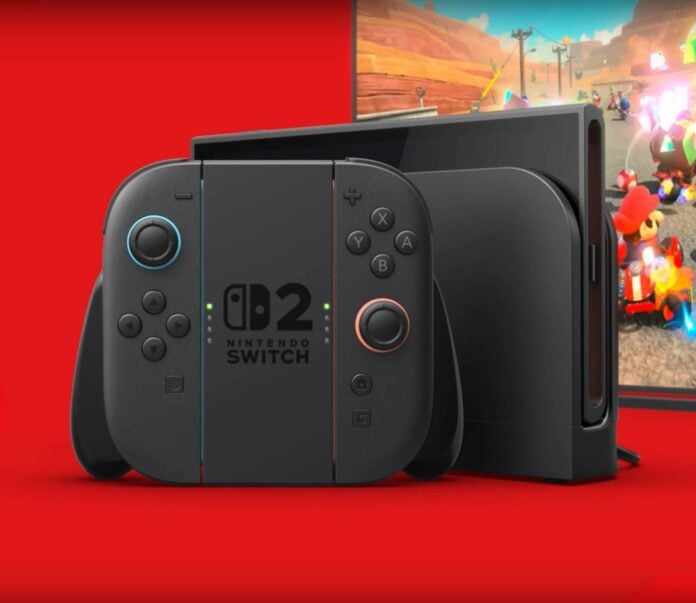Nintendo has unveiled the complete specs of its upcoming Switch 2 gaming console, shedding light on its inner workings. Set to launch on June 5, the handheld represents a significant technological leap over its predecessor, combining more-advanced hardware with modern performance enhancements.
Switch 2 boasts custom Nvidia T239 SoC (system-on-chip), housing an octa-core ARM Cortex-A78C CPU. From these, six cores handle game processing, with two reserved for system operations. These cores will run at 998MHz when docked and 1.1GHz in handheld mode, with a potential boost up to 1.7GHz in some scenarios. The latter could operate like Switch 1, where the GPU downclocks during loading screens to free more thermal headroom for the CPU to boost higher and finish its task faster.
Unlike Switch 1 where Nintendo incorrectly described the Nvidia Tegra processor as a custom design, Switch 2 truly has custom silicon specifically designed to cover its needs.
| Switch 1: Nvidia Tegra X1 | Switch 2: Nvidia T239 | |
| CPU | 4x ARM Cortex A57 | 8x ARM Cortex A78C |
| CPU Clocks | 1,020MHz (docked/mobile), Max 1.785GHz | 998MHz (docked), 1,101MHz (handheld), Max 1.7GHz |
| CPU System Reservation | 1 core (3 available to games) | 2 cores (6 available to games) |
| GPU | Maxwell | Ampere |
| CUDA Cores | 256 | 1,536 |
| GPU Clocks | 768MHz (docked), up to 460MHz (handheld), Max 921MHz | 1,007MHz (docked), 561MHz (handheld), Max 1.4GHz |
| Memory | 64-bit LPDDR4 | 128-bit LPDDR5 |
| Memory Bandwidth | 25.6GB/s (docked), 21.3GB/s (handheld) | 102GB/s (docked), 68GB/s (handheld) |
| Memory System Reservation | 0.8GB (3.2GB available for games) | 3GB (9GB available for games) |
On the GPU side, Switch 2 rocks a more modern design based on Nvidia’s Ampere architecture, which power GeForce RTX 30 Series cards. Inside, we find 1,536 CUDA cores clocked at 561MHz in handheld mode and 1,007MHz when docked. This should deliver around 1.71 TFLOPs of performance in handheld mode, and 3.07 TFLOPs when docked. Developers can adjust the maximum frequency up to 1.4GHz to further boost performance, though achieving and maintaining such speed isn’t always possible.
In terms of ray tracing, Switch 2 can handle 10 gigarays per second on paper, doubling up to 20 gigarays when docked. Overall, the Switch 2 should offer a performance similar to an RTX 2050 Laptop GPU. While it’s unlikely to beat Linux and Windows-based handhelds in raw performance due to its limited power budget, Switch 2 will benefit from Nvidia’s DLSS (Deep Learning Super Sampling) and ray tracing optimisations. These features should enable the console to maintain smoother visuals.
Moving to memory, Switch 2 carries two 6GB modules, totalling 12GB of LPDDR5X. From this, the system reserves 3GB for itself, leaving 9GB for developers to play with. For comparison Switch 1 shipped with 4GB, 3.2GB of which was available to developers. This indicates that the newer console requires much more memory to do run its operating system and non-gaming functions. Understandable since Switch 2 offers many new features, including a built-in webcam and mic, a game chat, mouse-like tracking, not to forget faster storage.
Talking of which, Switch 2 will carry 256GB of internal UFS 3.1 storage, expandable up to 2TB using microSD Express cards. Alongside the card reader, you will find two USB ports plus one HDMI output. The console also boasts a dedicated decompression engine that should accelerate this task all while reducing CPU load.
In summary, Switch 2 offers substantial upgrades in graphics processing power and features that should enhance the user experience. Seeing what Nintendo and developers managed to squeeze out of the previous console, Switch 2 seems even more exciting.

